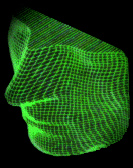Metaphors
Matthew Hutson, English 111, Brown University (1998)
As digital culture shatters and redistributes our pictures of realty and central authority loses relevence, a new kind of authority arises. Infinite mutability of simulacra in the form of digital media dilutes any claims of absolute legitimacy, yet also gives people the tools to design and publicize new visions of authority. Baudrillard describes the development of simulacra, and we see that people can now appropriate and remold any available media into any kind of false exoskeleton that they desire. Digital photographs can be retouched to show people lifting buildings or breathing fire. Propoganda, urban legends, and commercial archetypes spread across the globe like wildfire. The easy construction and propogation of imagined personalities that lie within the layman's hands simply invite the invention of superheroes, and, by extension, deities.
 As we find new ways of arranging and transfering bits, we must also create new metaphors for their use, new tools with which to manipulate and interact with them. The Macintosh graphic operating system creates a virtual deskop, with folders and a trashcan (and the Windows operating system give users a pseudo life-like virtual Macintosh.) We have information "superhighways," connecting a "global village," we "surf" an endless "stream" of information in the form of html "pages." Many of these technological metaphors provide intuitive tools for people to adjust to the digital realm, but Kai Krause has shown us that we can take this intuitive feel and stretch it beyond merely physical analogues.
As we find new ways of arranging and transfering bits, we must also create new metaphors for their use, new tools with which to manipulate and interact with them. The Macintosh graphic operating system creates a virtual deskop, with folders and a trashcan (and the Windows operating system give users a pseudo life-like virtual Macintosh.) We have information "superhighways," connecting a "global village," we "surf" an endless "stream" of information in the form of html "pages." Many of these technological metaphors provide intuitive tools for people to adjust to the digital realm, but Kai Krause has shown us that we can take this intuitive feel and stretch it beyond merely physical analogues.
In City of Bits, William Mitchell describes our new metaphors for the virtual communities and spaces we have built with digital technology. Steven Johnson also describes in his book, Interface Culture, the new environments we build with silicon:
As our machines are increasingly jacked into global networks of information, it becomes more and more difficult to imagine the dataspace at our fingertips, to picture all that complexity in our mind's eye -- the way city dwellers, in the sociologist Kevin Lynch's phrase, "cognitively map" their real-world environs.
. . . Representing all that information is going to require a new visual language, as complex and meaningful as the great metropolitan narratives of the nineteenth-century novel. We can already see the first stirrings of this new form in recent interface designs that have moved beyond the two-dimensional desktop metaphor into more immersive digital environments: town squares, shopping malls, personal assistants, living rooms. As the infosphere continues its exponential growth, the metaphors used to describe it will also grow in both scale and complexity. The agora of the twenty-first century may very well relocate to cyberspace, but it won't get very far without interface architects to draw up the blueprints.
Julian Scaff describes this exension of the interpolated reality that digital simulcra brings on within the context of art:
Not only does authenticity become meaningless, but space and time become an ambiguity for which we only have vague metaphors such as "cyberspace." With the digital reproduction of art there may still be an "original" somewhere in the world that was scanned, sampled, or otherwise digitized, but the digital art form takes on a life of its own.
